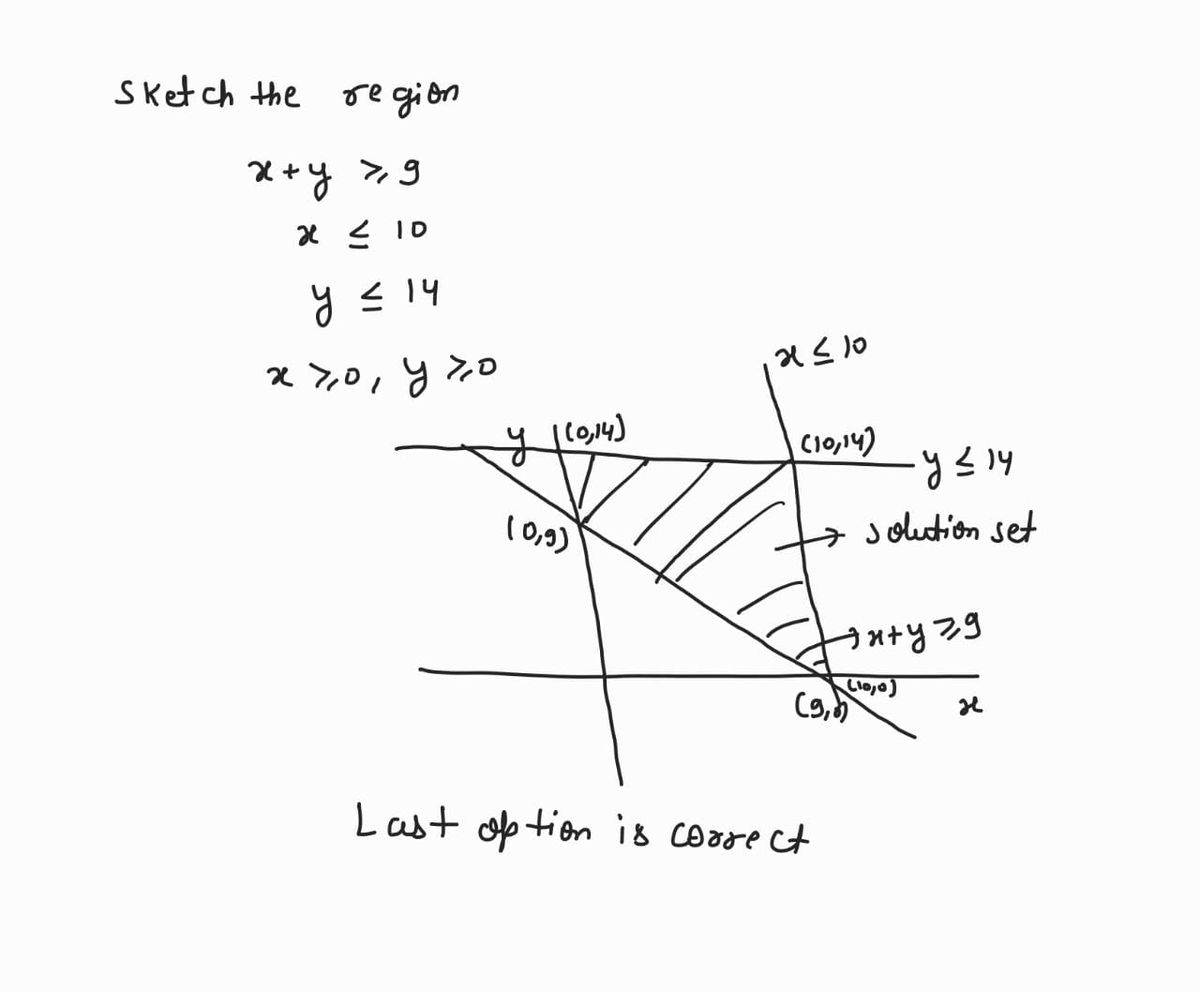Sketch the region that corresponds to the given inequalities. (image attached of the question) x + y ≥ 9 x ≤ 10 y ≤ 14 x ≥ 0, y ≥ 0 Say whether the region is bounded or unbounded. The region is bounded.The region is unbounded. Find the coordinates of all corner points (if any). (Order your answers from smallest to largest x, then from smallest to largest y. If an answer does not exist, enter DNE.)
Sketch the region that corresponds to the given inequalities. (image attached of the question) x + y ≥ 9 x ≤ 10 y ≤ 14 x ≥ 0, y ≥ 0 Say whether the region is bounded or unbounded. The region is bounded.The region is unbounded. Find the coordinates of all corner points (if any). (Order your answers from smallest to largest x, then from smallest to largest y. If an answer does not exist, enter DNE.)
Advanced Engineering Mathematics
10th Edition
ISBN:9780470458365
Author:Erwin Kreyszig
Publisher:Erwin Kreyszig
Chapter2: Second-order Linear Odes
Section: Chapter Questions
Problem 1RQ
Related questions
Question
Sketch the region that corresponds to the given inequalities. (image attached of the question)
| x | + | y | ≥ | 9 |
| x | ≤ | 10 | ||
| y | ≤ | 14 |
x ≥ 0, y ≥ 0
Say whether the region is bounded or unbounded.
The region is bounded.The region is unbounded.
Find the coordinates of all corner points (if any). (Order your answers from smallest to largest x, then from smallest to largest y. If an answer does not exist, enter DNE.)
(x, y) =
(x, y) =
(x, y) =
(x, y) =
(x, y) =

Transcribed Image Text:The problem requires sketching the region that corresponds to a set of inequalities:
1. \(x + y \geq 9\)
2. \(x \leq 10\)
3. \(y \leq 14\)
4. \(x \geq 0\), \(y \geq 0\)
There are four different graphs provided. Each graph is a coordinate plane with:
- The x-axis ranging from \(-5\) to \(20\).
- The y-axis ranging from \(-20\) to \(20\).
- A highlighted blue solution set region.
**Graph Analysis:**
1. **First Graph:**
- The solution set is shown in blue, primarily in the first quadrant.
- Boundaries:
- A vertical line at \(x = 10\)
- A horizontal line at \(y = 14\)
- A diagonal line from \((0,9)\) to \((9,0)\), representing \(x + y = 9\)
2. **Second Graph:**
- Similar to the first graph but different shading within the solution.
- Boundaries:
- Identical to the first graph.
3. **Third Graph:**
- Solution set is altered to a different section of the coordinate plane.
- Boundaries:
- Same constraints as the previous graphs.
4. **Fourth Graph:**
- Solution set moved again.
- Boundaries remain unchanged; only shaded area representing the solution set moves.
**Other Information:**
There's a question at the bottom to determine if the region is bounded or unbounded. Additionally, there's a task to find the coordinates of all corner points in the region, in increasing order of \(x\) and \(y\), specifying that if an answer doesn't exist, enter "DNE."
Each corner point can be found by solving the inequalities simultaneously to determine points of intersection:
- **(\(x, y\)) =**
- **(\(x, y\)) =**
- **(\(x, y\)) =**
- **(\(x, y\)) =**
- **(\(x, y\)) =**
Expert Solution
Step 1

Step by step
Solved in 3 steps with 3 images

Recommended textbooks for you

Advanced Engineering Mathematics
Advanced Math
ISBN:
9780470458365
Author:
Erwin Kreyszig
Publisher:
Wiley, John & Sons, Incorporated

Numerical Methods for Engineers
Advanced Math
ISBN:
9780073397924
Author:
Steven C. Chapra Dr., Raymond P. Canale
Publisher:
McGraw-Hill Education

Introductory Mathematics for Engineering Applicat…
Advanced Math
ISBN:
9781118141809
Author:
Nathan Klingbeil
Publisher:
WILEY

Advanced Engineering Mathematics
Advanced Math
ISBN:
9780470458365
Author:
Erwin Kreyszig
Publisher:
Wiley, John & Sons, Incorporated

Numerical Methods for Engineers
Advanced Math
ISBN:
9780073397924
Author:
Steven C. Chapra Dr., Raymond P. Canale
Publisher:
McGraw-Hill Education

Introductory Mathematics for Engineering Applicat…
Advanced Math
ISBN:
9781118141809
Author:
Nathan Klingbeil
Publisher:
WILEY

Mathematics For Machine Technology
Advanced Math
ISBN:
9781337798310
Author:
Peterson, John.
Publisher:
Cengage Learning,

